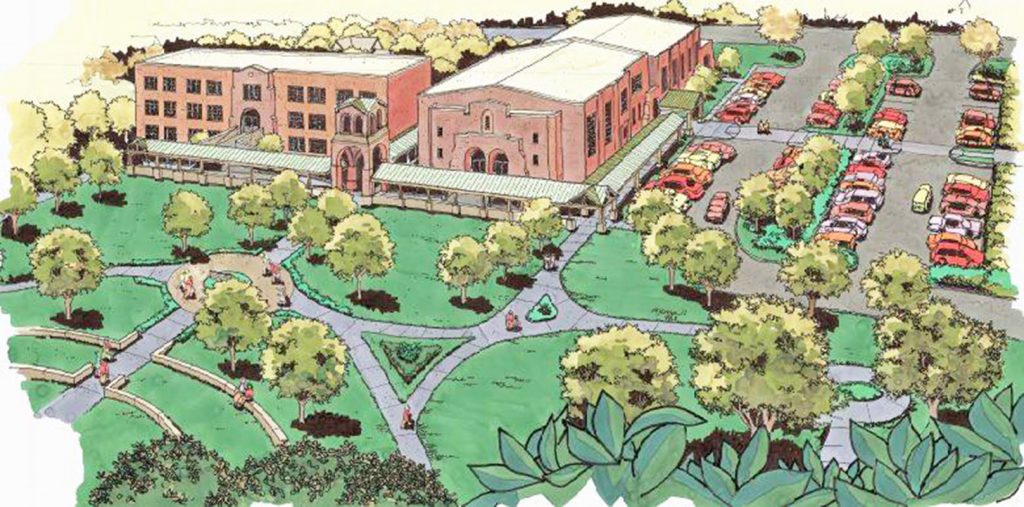Council Chairman Moses Bell says the cost of the Mt. Zion contract is unknown and has appointed an ad hoc committee to determine those costs. That information, county officials say, has been readily available from the county and from the developer.

WINNSBORO – During a Feb. 10 county council special called meeting, Council Chairman Moses Bell appointed an ad hoc committee to research the county’s contract with developer 1st and Main to determine the county’s costs to renovate the former Mt. Zion buildings for use as a county administration building.
While the cost estimates were somewhat fluid early on, they were made public on a number of occasions prior to the signing of the contract, including during a public forum the county hosted on Sept. 20, 2018. Those costs, The Voice’s research shows, have changed for the better (for the County) since the contract was signed, County officials say the contract and its amendments spell out the costs and that the contract, its amendments and the costs have always been readily available to council members and the public.
Bell said at the Feb. 10 meeting that he is frequently asked about the costs of the contract which he insists are not fully known.
Ad Hoc Committee
“I want to appoint an ad hoc committee to review the Mt. Zion contract to determine the cost to the county from the beginning to the end based on the contract,” Bell said during the meeting.
Councilman Doug Pauley reminded Bell that the answers to his cost-related questions can be found in recordings of the various public meetings and town halls the council held on the subject.
“I’ll tell you what’s amazing to me,” Pauley said, “except for Ms. Greene and Mr. Roseborough, who have recently been elected, all five of us were on council when the Mt. Zion contract was signed. Now we get to this point and you don’t have a clue what was spent, what was discussed.”
Bell appointed Councilwoman Shirley Greene and Councilmen Tim Roseborough and Neil Robinson to serve on the committee, charging them to “bring back to council what that contract looks like and what’s in it and what we need to do going forward.”
Greene, who has long, publicly and vehemently opposed the project, spoke out against it during numerous county council meetings before the contract was signed. Bell, Trapp and Pauley voted against the project.
During public comment at the Oct. 8, 2018, meeting, Greene addressed a list of costs, besides construction costs, she said the county would incur if it purchased the renovated building – wi-fi, internet, phone installation and services, furniture, window coverings, electricity, gas and water, heating and cooling, security, cleaning supplies, insurance, HVAC maintenance, generators to keep 911 and the Sheriff’s services live during electrical outages and additional maintenance outside and inside the complex.
“We would have that cost associated with any move, whether we renovated this building, built a new one or renovated Mt. Zion,” Taylor told The Voice.
No timeline was set for the committee to meet, but Bell charged the committee to bring the answers to their research back to council in 60 days.
“Shouldn’t we be looking forward instead of looking backwards?” Councilman Clarence Gilbert asked. “It just doesn’t make any sense. We as a council and the administrator should be moving Fairfield County forward, not backward.”
Greene countered by saying it’s the council’s responsibility to evaluate how taxpayer money is spent.
“We’re responsible for making sure our money is spent judiciously. We can’t do that if the [cost] information for the renovation isn’t in front of us,” Greene said.
$8.9 Million Max
That information, it turns out, is readily available. The Voice obtained the County’s contract and amendments through a Freedom of Information request, then spoke with both Assistant County Administrator Laura Johnson and developer Rory Dowling, CEO of 1st and Main, who clarified the updated costs of the Mt. Zion renovation over the phone.
They said on Tuesday that the County’s total costs per the contract will not be more than $8.9 million, max, and most likely, less.
While the entire project will cost around $13+ million, the County’s costs are limited to:
$175,000 design fee (paid up front),
$1 million escrow for drawdowns (most of which will likely not be drawn out and will be returned to the county),
a maximum $4.2 million in interest-free lease payments over seven years and
a maximum $4.5 million final payment.
“The $4.2 million and $4.5 million amounts are expected to come in lower,” Dowling said, “again saving the County money over what was originally estimated.”
Johnson said estimated cost to the County was fluid from the beginning, depending on the tax credits 1st and Main would be able to receive.
Made Possible by Tax Credits
“What makes this development affordable for the county is that the developer was able to secure tax credits from several sources to cover much of the renovation costs,” Johnson said. “Those are costs the county doesn’t have to pay for.”
Dowling said 1st and Main is expected to receive about $7 million in tax credit equity from three sources: historic tax credits, new market tax credits and SC abandoned building tax credits.
“The tax credits work like this,” Dowling explained, “if we, as the owner/developer, can sell the tax credits to a third party financial institution for $.75 on the dollar, we can use that money as equity for financing the project.”
“This plan, if the county stays the course, will save the county millions of dollars compared to any viable alternative for addressing the county’s physical office needs,” Taylor said.
Cost Per Sq. Ft. Savings
Dowling said a building of this magnitude for a county administrative building that includes sheriff’s offices and a 911 call center would cost approximately $300 – $350 per square foot, well over $15 million.
“Instead, the county is paying $180 per square foot, a big savings,” Dowling said.
While project naysayers have criticized the county for not renovating the current administration building or building a new one, County Administrator Jason Taylor said to do either is cost prohibitive.
“[Mt. Zion] was the only option we could afford to do,” Taylor said. “Replacement of just the electrical, HVAC and roof of the current county building would cost over $4 million. To renovate and expand that building would cost much more than it would cost to repurpose Mt. Zion, which will offer so much more space and be a safe, efficient, like-new building.
“Even if we had the up-front money to renovate the current county building, there would be additional costs to find offices for employees while the renovations were being done,” he said. “Building out a temporary location would cost just as much, if not more.”
There will be space in Mt. Zion to house the Courthouse offices while renovating the current Courthouse, also saving the county thousands, perhaps millions of dollars, according to Taylor.
Summer Move-In
Dowling said last week that while the project has had some delays caused by COVID, the entire project should be completed by the end of summer.
“The top two floors of the main classroom building will serve as the new administration offices, complete with a new elevator and staff should be able to start moving in by mid to late summer,” Dowling said. “The Sheriff’s Office and 911 will be located on the first floor.”
The former auditorium will house the council chamber and perhaps the town’s community theater group, receptions, church groups and weddings.
“We’re restoring 400 to 500 historic seats in the auditorium and there’s additional open floor capacity,” Dowling said. “The gym will be fully restored and the former cafeteria will be used to expand the county’s early childhood education facilities. It’s coming together. Everything is looking good. The entire building will all be finished out even though some of the space may not be used just yet.”
Besides the financial bargain of the facility for the county, Taylor said the project will also save a historic property that had become an eyesore in the town, and it will place the county’s center of government, with all of its employees and visitors, in the heart of downtown Winnsboro, likely driving much more daily traffic to Winnsboro’s main street merchants.
Intentions of Committee
Former Council Chairman Neil Robinson said at the Feb. 10 meeting that he worries the true intention of the Mt. Zion ad hoc committee is to lay the groundwork for cancelling the contract.
“Before this new council came in, it was already said that the first thing on their agenda was to tear down current projects,” Robinson said. “It kind of seems like we’re following suit with that. If we spend two years digging up all the old stuff to make sure it’s correct, we won’t get anything done,” Robinson added. “If the ultimate goal is to tear down this project, we’re probably looking at a $13 million lawsuit we can’t afford.”
Billy Smith, County Council Chairman at the time the contract was signed, agreed.
“If council simply votes at this point to exit the contract,” Smith said, “the county will have to pay specific exit fees agreed to in the contract and for all work performed so far, they’d very likely have to cover the millions of dollars the tax credits would have been worth to the developer, and I would imagine the developer would have every attorney within 100 miles vying to represent them in a substantial lawsuit against the County.”
What About the Bid?
Bell also said he is concerned that since, according to him, the County only got one bid on the renovation of the building, that the contract might be invalid.
“As we have said before, there never was a bid process,” Taylor told The Voice, “because we never owned the building. It wasn’t a biddable item. The Town of Winnsboro owned the property and deeded it over to 1st and Main who owns it now and is bearing the cost of renovation. The County signed a contract with the developer stating that, after the project is completed, it [the County] will lease the property over seven years via interest-free annual lease payments, then purchase it.
“We didn’t select the contractor since it’s not our building. We didn’t do the legal or the design work on it,” Taylor said. “This was a turnkey project that they brought to us and would renovate for X number of dollars. We were not in a position to issue more bonds or borrow more money – we could afford this [lease/purchase] agreement, and it won’t hurt our credit or bond ratings.
“The renovation of Mt. Zion will be very nice,” Taylor said, “and could lead to the county’s 120 employees shopping and eating in downtown Winnsboro every day, spending more money downtown,” he said. “It will be good for our employees and good for our downtown merchants and restaurants. Plus it’s a bargain for the county, any way you look at it.”











